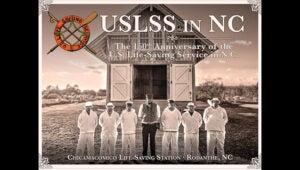USLSS in NC: The end of an era
Published 1:51 pm Saturday, December 28, 2024

- The Omar Babun. Courtesy Outer Banks History Center
|
Getting your Trinity Audio player ready...
|
By Jen Carlson
During the wee hours of May 14, 1954, a freighter named the Omar Babun ran into rough seas and high winds just off the coast of North Carolina. The cargo of heavy machinery came loose from its bindings and was a threat from within.
In an effort to save his crew, the vessel’s captain intentionally beached the freighter and sent out a distress call. Multiple crews responded and the rescue operation began at daylight.
In just over two hours, all 14 crew members were brought safely ashore with the breeches buoy.
Initially, the thought was that the Omar Babun and her cargo would be lost to the ocean. However, due to the extensive efforts of a salvage operation, just over two months after the incident, the now-empty freighter was successfully refloated and towed to Norfolk.
The significance of this rescue became known later as it was the final official breeches buoy rescue in North Carolina. The Chicamacomico Coast Guard Station had been decommissioned by the time of the Omar Babun incident. However, there were two caretakers still onsite and the younger of the two Guardsmen hitched up a horse to the station’s beach apparatus cart and brought the needed equipment to the scene, about three miles north of the station.
By the late 1950s, the beach apparatus rescues were being phased out and replaced with helicopter rescues. While the methods have changed with the times, the expectations of General Superintendent Sumner Kimball remain true to this day and the overall goal remains the same: save lives.
All in a Day’s Work
Sometimes it’s about risking your life in unexpected ways: On August 18, 1896, the crew from the Whales Head Lifesaving Station (formerly known as Jones Hill) responded to a distress flag flown by a vessel, Tenax Propositi.
Once arriving at the vessel’s side, Keeper Jesse E. Ward and crew discovered the vessel’s master had died from illness and there were others onboard sick as well. The first mate was unsure of their position so he asked for the course and distance to Hampton Roads. Keeper Ward provided the requested information and after returning to the station, reported the vessel to both quarantine officials and Cape Henry pilots.
For more stories like these, visit the Chicamacomico LifeSaving Station where history is alive.
READ MORE IN THIS SERIES HERE:
SUBSCRIBE TO THE COASTLAND TIMES TODAY!







